Where does the federal government get to work? The Hill, of course. Make sure you know where important Congressional offices, Libraries, and of course The Capitol are.
Download PDF
Download the full PDF here.
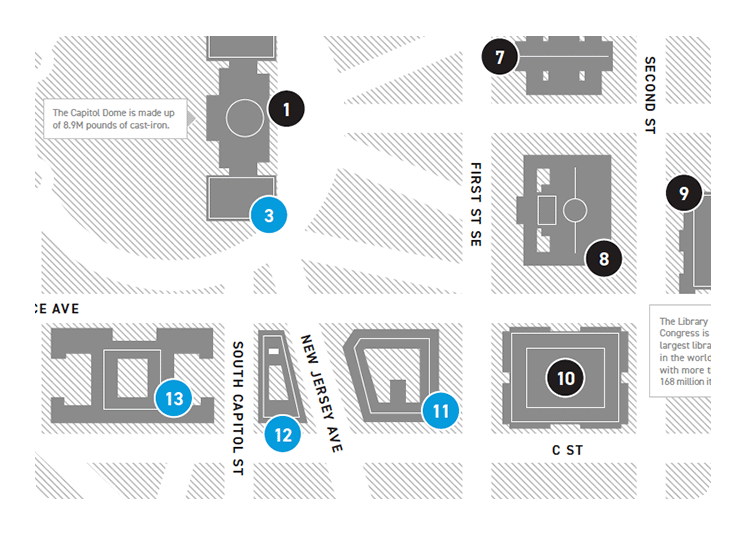
by Pro Team
Where does the federal government get to work? The Hill, of course. Make sure you know where important Congressional offices, Libraries, and of course The Capitol are.
Download PDF
Download the full PDF here.

by Pro Team
Over the past 40 years, the average time for the Senate to reach a final vote on a Supreme Court justice nominee has been 72 days — nearly twice the time left before the 2020 general election.
The modern process of confirming Supreme Court justices has three major stages: First, the president chooses and announces their nominee for the court. Second, the nominee is exhaustively vetted by the Senate Judiciary Committee. In the final stage, the whole Senate debates and votes to confirm or reject the nominee.
Historically, senators have avoided filibustering the confirmation process, and a change to Senate rules in 2017 effectively ended the practice by allowing debate to end with a simple majority vote. As a result, the party that controls the Senate can complete the entire process without any votes from the minority party — and in recent years, confirmation votes have increasingly fallen along party lines.
1. Initial research on nominee
Prior to a hearing, Judiciary committee members review information about the nominee from several sources, including a detailed questionnaire for the nominee drafted by the committee.
At this stage, the nominee will typically meet individually with members of the committee and other interested senators in their offices.
2. Hearing before the Senate Judiciary Committee
The committee will eventually hold a public hearing to receive the nominee’s testimony. Typically, the hearing is held approximately 40 days after the nomination is first made.
Senators ask questions in multiple sessions spanning four or five days, with the option to hold additional hearings for controversial nominees.
3. Final report from the committee
Approximately one week after the hearing, the committee meets in an open session to determine its recommendation for the Senate.
Depending on how the members vote, the nominee may be reported “favorably” or “unfavorably.” Regardless of the outcome, the committee typically allows the nomination to move to a full Senate vote.
4. Majority Leader sets schedule for debate
Typically the Majority Leader consults with the minority leader to determine the timing and length of the proceedings, so that the process can begin via unanimous consent.
If unanimous consent cannot be secured, the majority leader can make a filibuster-proof motion to begin the process.
5. Senators debate on the floor
Unless the minority party agrees to a shorter schedule, the nomination will be debated for a minimum of 30 hours on the Senate floor.
Each senator who takes the floor gives a speech explaining why they are voting to confirm or reject.
6. Full Senate vote for confirmation
Once debate ends, senators may vote on the nominee. Since 1967, every Senate vote to confirm a Supreme Court justice has been a roll call vote — meaning each senator’s vote is formally recorded. Historically, most confirmation votes have resulted in an overwhelming majority in favor. However, in recent years, party-line votes with a substantial minority voting to reject have become more common.
Download the full DataPoint >>
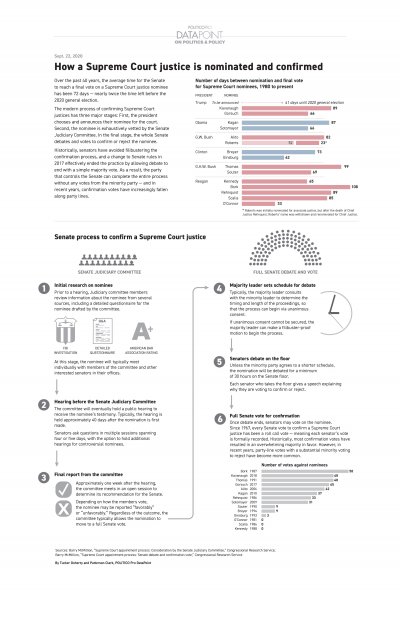
This post is excerpted from a DataPoint infographic that was initially made available to POLITICO Pro Premium subscribers on September 22, 2020.
If you would like to learn more about POLITICO Pro Premium, you can visit this page.
by Pro Team
Ranked-choice voting allows citizens to rank their candidate preferences on an election ballot instead of voting for a single candidate. If one candidate does not initially win a majority, competitors with the fewest votes are eliminated from the race and their voters’ second choices are applied to the tallies of the remaining candidates until one candidate achieves a majority.
According to the group FairVote, two states have 2020 ballot initiatives to install a statewide ranked-choice system. Alaska’s Ballot Measure 2 would replace partisan primaries with an open primary in which the top four finishers advance to a ranked-choice general election, while Massachusetts’ Question 2 would retain partisan primaries but implement ranked-choice voting in both primaries and the general election starting in 2022.
Maine’s state Supreme Court voted on Sept. 8 to allow ranked-choice voting to appear on 2020 presidential election ballots but has not decided whether a ballot initiative challenging the use of ranked-choice voting will actually keep voters from selecting candidates that way.
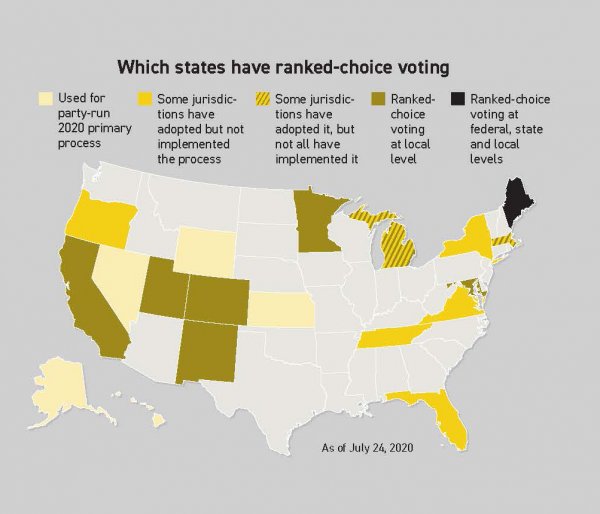
Voters can choose to rank candidates, indicating on a ballot which person is their first choice, second choice, third choice, etc., for election to office.
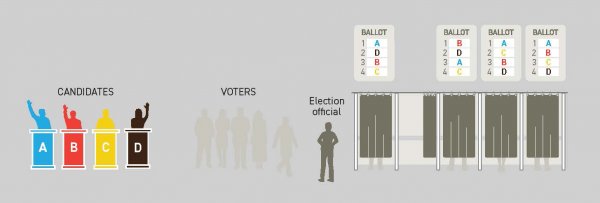
If one of the candidates receives more than 50 percent of the first-preference votes, that candidate wins the election.

If no candidate receives more than 50 percent of the votes, the candidates with the lowest percentages of votes are eliminated and their supporters’ second-choice selections are allocated to the remaining candidates on the ballot. This vote-redistribution process continues until one candidate reaches over 50 percent of the cast votes.
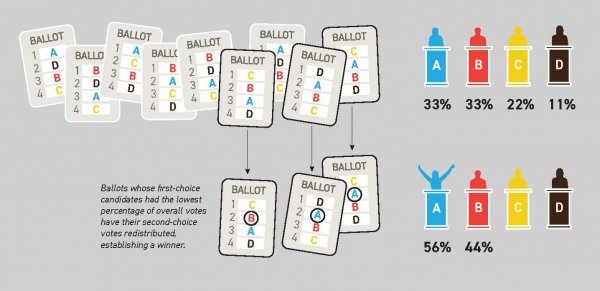
Could ensure that a winning candidate has a majority of votes
In elections in which there are several candidates, ranked-choice voting allows voters to support like-minded competitors to defeat an unfavored candidate. Fractured opposition can result in an unfavored candidate winning an election even if most voters oppose them.
Voters’ ballots count, even if their first choice loses
Even if your first-choice candidate loses, your vote still counts toward electing a candidate of your choice.
Voters’ choices may not count if all of them are eliminated
If a voter does not rank all of the candidates’ names on a ballot, leaving some selections blank, and if all of the voter’s choices are eliminated, that could result in the ballot not being counted at all.
This post is excerpted from a DataPoint infographic that was initially made available to POLITICO Pro Premium subscribers on September 10, 2020.
If you would like to learn more about POLITICO Pro Premium, you can visit this page.
by Pro Team
The Greater Oklahoma City Chamber acts as the voice of business in Oklahoma City. The Chamber represents thousands of businesses of all sizes and all industries in Oklahoma City’s 10-county region. The Chamber’s goal is to work to create a business climate that attracts new investment and enhances growth and expansion opportunities for existing companies.
Although Oklahoma City is the 25th largest city in the United States (measured by population), the Greater Oklahoma City Chamber is one of the top five largest chambers of commerce. Each year, in collaboration with its members, the Chamber develops a robust, yet targeted legislative agenda representing the issues that the Chamber’s Government Relations team will actively engage elected officials on. The Chamber’s 2020 agenda includes over 70 federal and state items, representing policy priorities across a range of issue areas including education and workforce development, healthcare, transportation, energy, criminal justice and more.
“Everything we advocate for here at the Chamber is focused on creating a positive business environment in Oklahoma City. You’d be surprised by the range of issues that touch on our mission as an organization,” says Derek Sparks, Senior Manager of Government Relations for the Greater Oklahoma City Chamber. “And, we need to have a voice on each one,” says Sparks.
Since 2013, POLITICO Pro has helped streamline the Chamber’s work and provides a single source of reliable information. “POLITICO Pro is my one-stop-shop. I don’t have to go aggregate dozens of sources, I just follow Pro. Everything I need is right there in my inbox or when I log in to the platform,” says Sparks.

Over the last eight years, the Chamber’s Government Relations team has leveraged POLITICO Pro to help the Chamber navigate a range of issues including advocating for the reauthorization of the Export-Import Bank Act, navigating the reauthorization of the Surface Transportation Act, which resulted in $643 million in federal funding for Oklahoma, and most recently understanding how the Coronavirus pandemic and related relief packages would impact businesses in Oklahoma City.
With the help of POLITICO Pro, Sparks and the Chamber’s government relations team can track policy developments in real-time as they unfold, understand the impact they have on the Chamber’s agenda, and create a strategy to advance their policy priorities.
In 2015, the Chamber successfully advocated for the reauthorization of the Export-Import Bank Act, which impacted many chamber members like Boeing, by getting former Congressman Steve Russell “from being a hard no all the way to yes,” says Sparks. “If I hadn’t had POLITICO Pro’s reporting on this issue on hand for our meetings with the congressman, which was a subject being underreported in general, I wouldn’t have had a substantial enough understanding of how things were developing. Ultimately, we were able to show the Congressman how valuable Exim is to some of our major members and POLITICO Pro’s reporting was key to that.”
Most recently, the Chamber’s government relations team has had to completely rethink their 2020 agenda in the face of the Coronavirus pandemic. “We have the double-whammy in our state between the Coronavirus pandemic and a historic downturn in oil and gas prices,” which accounts for at least 35% of the state’s budget, says Sparks. Through this crisis, Sparks was able to rely on POLITICO Pro for in-depth, actionable intelligence, “While working remotely, Pro’s reporting has been invaluable…it provides continuity, consistency, stability and even a sense of normalcy. It’s the inside baseball that I devour and allows me to know what’s going on and to keep our members up-to-date.”
“And, to top it off – the customer service is phenomenal.”
This content was produced outside of the POLITICO Pro newsroom.
by Pro Team
Nacha is a nonprofit organization that is the steward of the ACH Network, an electronic payment system that universally connects all U.S. bank accounts and enables Direct Deposit and other electronic payments. In 2019, 24.7 billion payments and nearly $56 trillion in value moved across the ACH Network.
In March, as Americans started to feel the impact of Covid-19 with businesses closing and unemployment growing daily, the federal government began work on the largest economic stimulus package in U.S. history — the CARES Act. Nacha, the organization responsible for overseeing the ACH Network, quickly began monitoring one of the most significant parts of the legislation with the help of POLITICO Pro — direct payments to Americans estimated to total up to $300 billion.
On March 17th, Treasury Secretary Steven Mnuchin announced that the Trump administration was considering offsetting the economic burden of the coronavirus pandemic by “immediately” cutting checks to Americans. Rapidly changing and conflicting information was being shared about how these payments would be delivered to Americans and when.
“Our goal was to communicate to all the stakeholders involved in making the payments that the ACH Network was ready for this historic event,” says William Sullivan, Nacha’s Senior Director and Group Manager, Government and Industry Relations. “Our message was that the ACH was ready for this major event and that the payments could be sent efficiently, safely, and quickly to Americans through Direct Deposit.”
In addition to communicating the ACH Network’s preparedness to the federal government, Nacha also wanted to ensure that its members felt prepared to answer their customer’s questions about how and when stimulus payments would be delivered.
With information about the CARES Act and the delivery of stimulus payments rapidly changing, POLITICO Pro helped Nacha understand the impact to the ACH Network and its members and get up to speed quickly so they could create an effective communications strategy.
“POLITICO Pro’s reporting gives us concise, yet comprehensive information in an easy to read format and be able to run with it,” says Sullivan. Then using POLITICO Pro’s legislative and regulatory trackers, Nacha was able to stay informed. “From monitoring the legislation’s proposal to passage, I was able to understand the intent Congress had for the stimulus payments, and then how Treasury was going to implement the program. I know when I get an alert from Pro, I have to read it immediately so I don’t get blindsided by something.”

In addition to tracking the CARES Act, POLITICO Pro helped Nacha anticipate member questions about how payments would be handled for Americans who don’t typically file tax returns – “I would find out something very nuanced but impactful that the IRS was doing but hadn’t been communicated from POLITICO Pro. Then, using the POLITICO Pro Document Drawer, I was able to go back and find the press release and be able to anticipate the barrage of questions I’d receive the next day from members. It’s been invaluable.”
With the help of POLITICO Pro, Nacha was able to develop a comprehensive communications strategy to signal their member’s preparedness for this event to the federal government. “We were able to help bring all the industry groups together with one voice, so Treasury wasn’t overwhelmed with our questions or suggestions about how to handle payments. We were speaking as one,” said Sullivan.
To date, the ACH Network has processed approximately 120 million Economic Impact Payments, or about 75% of the total Economic Impact payments to citizens under the CARES Act.
“To sum it up, POLITICO Pro can really be the difference between being on your toes and proactive or being completely blindsided, on your heels and reactive.”
This content was produced outside of the POLITICO Pro newsroom.
by Pro Team
POLITICO Pro offers two plans: POLITICO Pro Plus and POLITICO Pro Premium. This blog covers the additional analysis content included in the Premium plan.
The complex nature of today’s policy environment requires that you become a fast expert on policies and issues that are quickly emerging and rapidly changing.
In addition to the news and tools included in every POLITICO Pro subscription, POLITICO Pro Premium delivers Premium subscribers in-depth analyses from our team of policy and legislative experts. Our analyses help policy professionals understand today’s most critical policy issues and lead the conversation about them. Whether you need to build your own knowledge on emerging issues or educate your colleagues and stakeholders on potential impact and outcomes, Pro’s Premium plan will help you activate quickly and confidently.
Our analysis content is designed to help you:
Here’s an overview of the three types of content included in this plan:
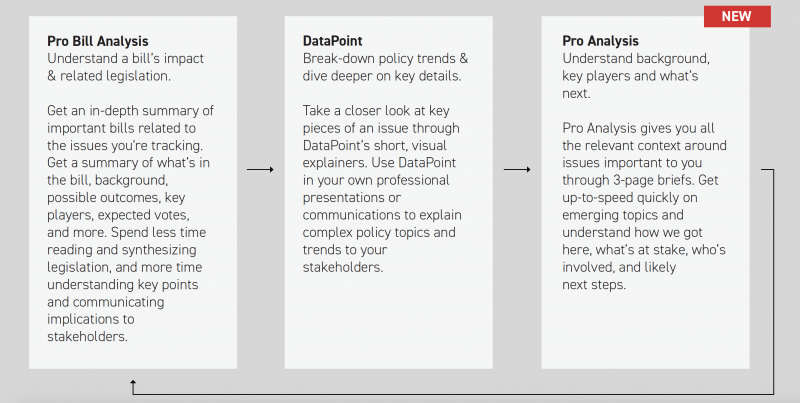
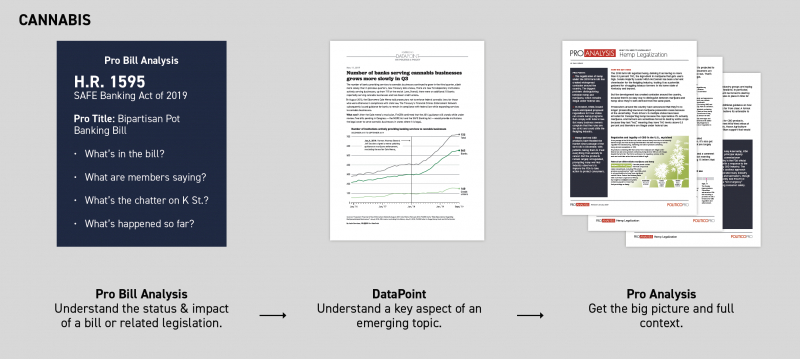
This agenda represents a small sample of topics we have covered and expect to cover. This is subject to change at our discretion as news and events develop across the year.
International Tax Reform. The U.S. and other major world economies are struggling with how to tax digital services. While the OECD is trying to reach a compromise on that and other multinational tax issues, France and others are moving forward on their own, potentially derailing the OECD effort.
Health Care Data Privacy. The Trump administration will soon roll out its long-awaited interoperability rules and HHS is considering modifying medical privacy policy to give patients more control over their data. Some providers and big EHR companies are raising concerns over privacy and urging delay.
Data and Consumer Privacy. With CCPA enacted in California and Congress considering the Consumer Online Privacy Rights Act of 2019 (COPRA), big tech and policymakers at the state and federal levels debate how far-reaching federal legislation should go in regulating personal data.
Water & Flood Insurance. Examining the Water Resources Development Act of 2020 (WRDA), the National Flood Insurance Program and exploring how insurers, government agencies, and policymakers are planning for unprecedented weather events including heavy rainstorms.
Surprise Medical Billing. The House Ways and Means Committee has released a long-expected plan to eliminate surprise medical bills, setting up a showdown between several competing proposals from the House Energy and Commerce and Senate HELP committees.
by Pro Team
One meeting, one line of legislation or one leadership change can have a big impact on policy. POLITICO Pro is a smart, personalized policy intelligence platform that helps teams who create, influence or are impacted by policy do their jobs. We help you get informed quickly, act confidently and communicate effectively, so you can do what you do best – impact policy.
POLITICO Pro is a single destination that brings together policy reporting, data, analysis, and tools into one place — the Pro Edge platform. Rather than having countless disparate resources for the policy information you need, we’ve built one place where you can complete all your policy work.
One Pro customer said it perfectly,
As someone who has always done government relations work manually for organizations with small government relations teams, POLITICO Pro is AMAZING. Life-changing.
1. Understand Policy Movement and Context Quickly
POLITICO Pro helps you understand and contextualize policy movement the moment it happens. With Pro, you get access to all of our news across 21 coverage areas (16 policy areas, 4 states and Canada). Our suite of policy tools – like our legislative and regulatory trackers – then help you understand the full picture of major policy developments.
2. Make Strategic Decisions and Act Confidently
Decisions that impact the policies you care about often happen without any warning, but you need the facts to make strategic decisions. By bringing together smart technology, actionable data and the largest nonpartisan policy newsroom in the country, you can be confident you’re getting the most accurate and up-to-date information, so you’re always one step ahead.
3. Communicate Effectively and Lead the Conversation
Whether it’s your job to monitor, influence or implement policy, you need to communicate effectively with internal and external audiences. POLITICO Pro helps you get smart quickly, understand trends and arms you with the analysis you need to lead the conversation on the policies important to you and your stakeholders.
Want to learn about POLITICO Pro’s subscription plans? Visit our plans page.
Content produced outside of the POLITICO Pro newsroom.
by Pro Team
The POLITICO Pro platform brings together expert reporting and sophisticated policy intelligence tools to give you the intel you need to track and analyze policy and act on opportunities.
Expert reporters at your fingertips
Our team of over 100 policy-specific reporters get to the heart of the issue, so you get intelligence from subject-matter experts.
Delivering news when it breaks
Our breaking news alerts give you down-to-the-minute updates on major policy developments as soon as they happen. Customize alerts to meet your specific needs.
Written for Action
Pro content is written to get you up to speed quickly — our reporters write real-time updates in 250 words or less so you’re never caught off guard.
In-depth analysis
Written specifically for policy professionals, Pro articles provide in-depth analysis and insights so you will know what happened and why it matters to your organization, members, clients and constituents.
Get the highlights
Pro newsletters — delivered in the morning and afternoon — bookend your day with policy highlights. Our newsletters are written for busy professionals, meaning you receive only the insights you need, without having to dig through the clutter.
Customizable and Flexible Coverage
In the Pro Edge Platform, you can customize the niche coverage areas you need to follow. Reallocate subscription credits to the policy coverage areas that matter to you most, at any given time.
Want to see more from POLITICO Pro? Subscribe to our blog for exclusive policy content, product updates and more.
Content produced outside of the POLITICO Pro newsroom.
by Pro Team
On February 27, Democratic leadership in the House expected to celebrate a legislative victory on gun control legislation, instead, Republicans implemented a lesser-known procedural tool known as the motion to recommit, or MTR.
According to House rules, a motion to recommit provides one final opportunity for the House to debate and amend a measure before the Speaker orders a final vote on passage. While a motion to recommit can easily alter bill text, the majority of MTRs are quickly swept aside by the party in power. Thus, an MTR is more commonly used by the party in opposition to send a political message of protest before a final vote.
In fact, it is extremely rare for an MTR to pass. House Republicans did not lose a single procedural vote to Democrats in their previous eight years in the majority. But something unexpected happened when the Bipartisan Background Checks Act of 2019 (H.R.8) was on the House floor.
Prior to the final vote on H.R. 8, Republicans offered a motion to recommit pursuant to new language. This change required the notification of Immigration and Customs Enforcement if a background check revealed an illegal immigrant had attempted to purchase a firearm.
It proved to be a savvy move. By weaving a hot button immigration topic into the bill, Republicans managed to sway 26 Democratic members, predominantly from more competitive swing districts, to buck Democratic party leadership and vote for the motion.
According to POLITICO Pro’s Legislative Compass:
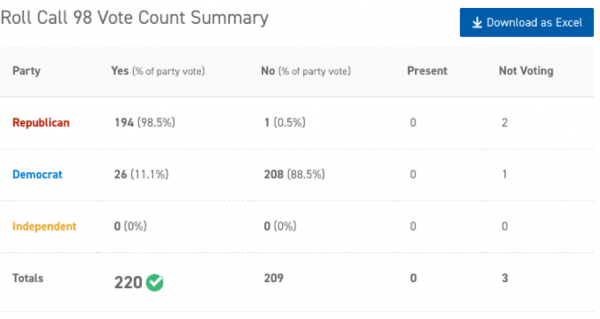
The House then passed the measure with the new language in a final vote of 240-190. Eight Republicans joined 232 Democrats in support of the measure, while two Democrats and 188 Republicans opposed it.
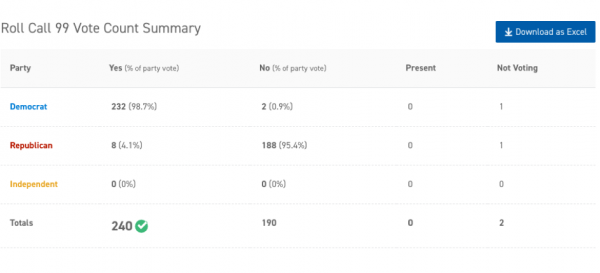
Democratic leadership has struggled to keep rank and file members in line on procedural votes. The setback on H.R. 8 was the second to befall the Democrats in February. They do not want this to become a trend.
The successful adoption of the MTR to H.R. 8 has exposed a fault line within the Democratic caucus. Moderate members seek the freedom to vote as they see fit to avoid angering voters in home districts. On the other hand, the more liberal wing of the party has members seething due to the inclusion of the MTR provision that could give more power to ICE, an entity that members have publicly called to abolish.
The bottom line is that the Democrats put themselves in a tough spot, one that could have been avoided. Republicans will likely try the tactic again in efforts to disrupt the majority’s legislative program.
For in-depth information on the history and usage of the MTRs, POLITICO Pro members can access this report from the Congressional Research Service (CRS): The Motion to Recommit in the House of Representatives: Effects and Recent Trends
